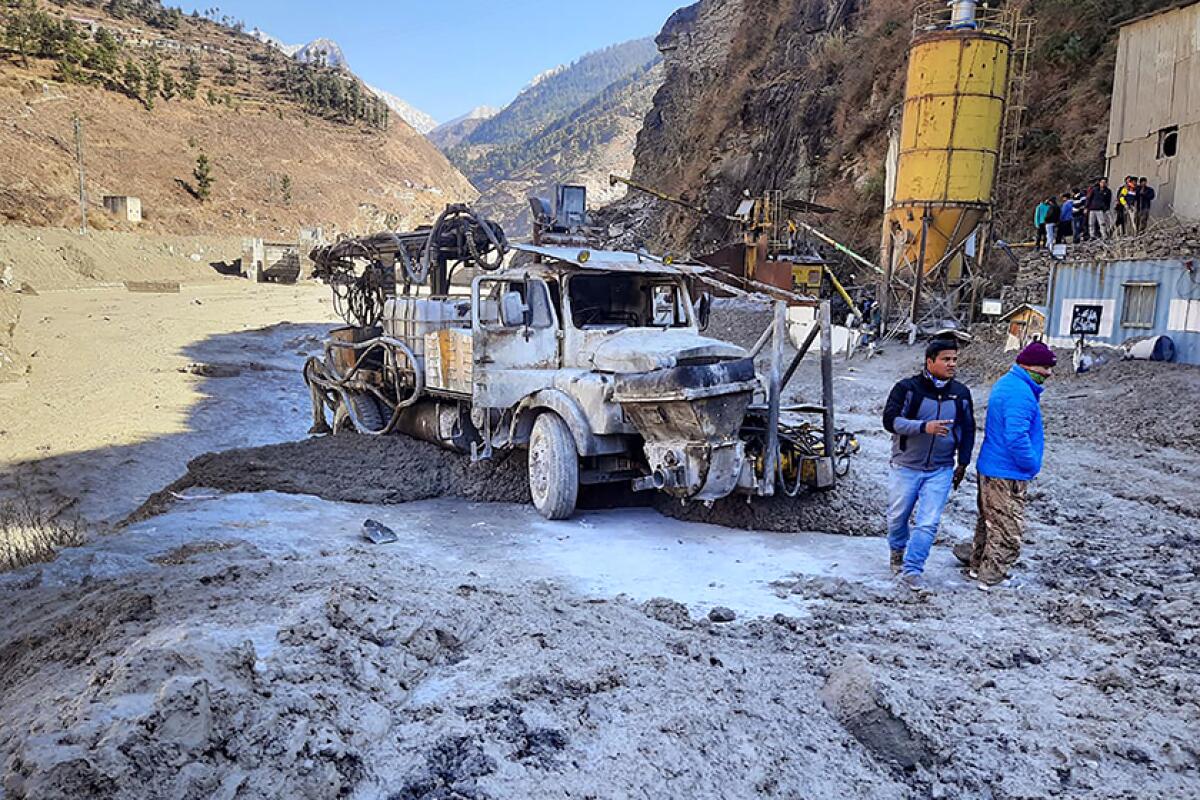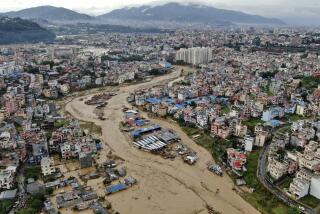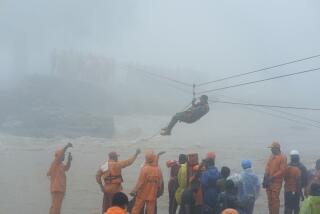At least 18 dead, 165 missing after glacier breaks in India; experts cite global warming

- Share via
RISHIKESH, India — Rescue crews struggled to reach trapped victims Sunday after part of a glacier in the Himalayas broke off and released a torrent of water and debris that slammed into two hydroelectric plants. At least eighteen people were killed and 165 were missing in a disaster experts said appeared to point to global warming.
Video from India’s northern state of Uttarakhand showed the muddy, concrete-gray floodwaters tumbling through a valley and surging into a dam, breaking it into pieces with little resistance before roaring on downstream. The flood turned the countryside into what looked like an ash-colored moonscape.
More than 2,000 members of the military, paramilitary groups and police took part in the search-and-rescue operation, including soldiers expert in mountaineering, working into the night under bright halogen lights, authorities said.
The flood was caused when a portion of Nanda Devi glacier snapped off in the morning, releasing water trapped behind it, authorities said. It rushed down the mountain and into other bodies of water, forcing the evacuation of many villages along the banks of the Alaknanda and Dhauliganga rivers.
A hydroelectric plant on the Alaknanda was destroyed, and a plant under construction on the Dhauliganga was damaged, said Vivek Pandey, a spokesman for the paramilitary Indo Tibetan Border Police. Flowing out of the Himalayan mountains, the two rivers meet before merging with the Ganges River.
Pandey said at least 42 workers were trapped in tunnels at the Dhauliganga project. Twelve were rescued from one of the tunnels, while at least 30 others remained stranded inside the other, he said.
“The rescuers used ropes and shovels to reach the mouth of the tunnel. They dug through the debris and entered the tunnel. They are yet to come in touch with the stranded people,” said Chief Minister Trivendra Singh Rawat, Uttarakhand’s top elected official.
An additional 140 workers at the two plants were missing, Pandey said. Surjeet Singh, a police official, said at least nine bodies were recovered.
The Himalayan area has a chain of hydropower projects on several rivers and their tributaries. Rawat said authorities were able to save other power units downstream because of timely action taken to release water by opening gates.
The floodwaters also damaged houses, said Ravi Bejaria, a government spokesman, though he had no details on the number and whether any of the residents were injured, missing or dead.
“It all started sometime around 10 in the morning. We heard a bang, which shook our village,” Dinesh Negi, a resident of Raini village, told the Associated Press by phone. He said they watched from high above one of the rivers as the water turned muddy and surged in a torrent.
“We knew something wrong had happened,” Negi said. “We could see the fury of the river.”
Video showed rescuers in camouflage uniforms and bright yellow or red helmets using ropes to reach victims. A man who was pulled from a muddy hole threw his arms in the air, and rescuers laughed and exulted with him. Rescue workers comforted victims lying in a row of stretchers in the open.
Scientists have long known that global warming is contributing to the melting and breakup of the world’s glaciers.
Anjal Prakash, research director and adjunct professor at the Indian School of Business who has contributed to United Nations-sponsored research on global warming, said that although data on the cause of the disaster were not yet available, “this looks very much like a climate change event as the glaciers are melting due to global warming.”
Uttarakhand Police Chief Ashok Kumar said officials immediately alerted residents in the area and evacuated them to safer places. Downstream, popular tourist spots on the banks of the Ganges were shut, and all boating activities were stopped.
Prime Minister Narendra Modi tweeted that “the nation prays for everyone’s safety” in Uttarakhand.
In 2013, thousands of people were killed in Uttarakhand after heavy rains triggered landslides and floods, washing away thousands of houses and roads and cutting communications links in many places.
More to Read
Sign up for Essential California
The most important California stories and recommendations in your inbox every morning.
You may occasionally receive promotional content from the Los Angeles Times.










